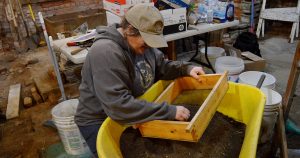NIU students digging deep to study history of Joseph Glidden
By Jessi LaRue For Chronicle Media — April 22, 2016
Savannah Leiby, NIU student and project volunteer, sifts through dirt of the surface layer in the barn. She is one of 10 archaeology and anthropology students using the project to gain experience in the field.
Northern Illinois University students are uncovering the history behind Joseph F. Glidden’s legacy – one layer at a time.
Eli Orrvar, NIU archaeology graduate student, is working with 10 student volunteers to dig up the floor of the Joseph F. Glidden barn on Lincoln Highway.
The barn is part of the Glidden Homestead, and is the location where Glidden first created his barbed wire invention during 1873 and 1874. The barbed wire he invented during this time would eventually be patented and declared “The Winner.”
The group of students is using the opportunity not only to gain real-world archaeology experience, but to educate others about the barbed wire baron.
The group is currently working through the surface layer of dirt on the barn’s floor. They hope to complete the entire project by the end of this summer, depending on what items the team can unearth.
In just the surface layer, the team has uncovered animal bones, nails and a glass medicine bottle. Orrvar is not sure what to expect once they get to the original layer from when the barn was built in 1870.
“I don’t have any expectations,” Orrvar said. “I just came in blank slate, with no idea what we’re going to find, and that’s kind of the attitude I’m keeping, because this barn is very mysterious, and we’re turning up stuff all the time.”
The team spends a few hours a day, four days a week working in the barn, clearing the surface layer and sifting through the dirt. Both Orrvar and Rob Glover, Glidden Homestead executive director, hope some barbed wire artifacts will come up from the dig.
Glover said the timeline of the barn’s history is incredibly unclear, so the dig may explain how the barn was used throughout its years.
Glover originally reached out to NIU’s anthropology department wondering how the homestead could go about digging into the floor of the barn, because the homestead would eventually like to pour concrete on the floor and convert the barn into a space that could be used as a continuation of the museum.
Orrvar explained to Glover how he would take on the project, and Glover offered him the project as volunteer work.
“We don’t know what to expect, there are so many uncertainties,” Glover said. “But it’s been really fascinating.”
Once the dig is complete, the discovered items will be researched. Glover and the homestead’s executive board hope the barn could be used as an interactive museum space once concrete is poured on the barn floor and the area is cleaned up and made safer. Glover said that project may not begin until next year.
Wes Richter, Glidden Homestead marketing intern, said using the barn as an interactive museum space would offer a “better visitor experience” for Glidden Homestead visitors. He said there’s plenty of learning opportunities during this project.
“We encourage people to stop by and check out the dig,” Richter said. “Come see history uncovered.”
— NIU students digging deep to study history of Joseph Glidden —



